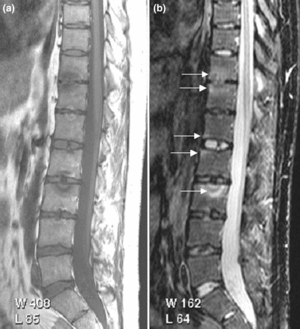Degenerative joint disease is overgrowth of bone and narrowing of the joint space caused by wear and tear of the joint cartilage. The swelling of the joints causes much pain and discomfort. The National Arthritis and Musculoskeletal and Skin Diseases Information Clearing house (NAMSIC) reports that almost 20.7 million adults in the United States suffer from degenerative joint disease, also known as osteoarthritis.
Degenerative joint disease is overgrowth of bone and narrowing of the joint space caused by wear and tear of the joint cartilage. The swelling of the joints causes much pain and discomfort. The National Arthritis and Musculoskeletal and Skin Diseases Information Clearinghouse (NAMSIC) reports that almost 20.7 million adults in the United States suffer from degenerative joint disease, also known as osteoarthritis.
Causes
Over the course of many years with activity and use of the joints, the cartilage begins to wear down and become injured or torn. In some cases, the cartilage wears away completely. When this happens, there is no cushion between the bones of the joint. The resulting gliding of bone against bone can cause stiffness, injury and pain.
The most commons causes of degenerative joint disease are overuse, heredity and injuries to and around the joint area. These injuries can be caused by fractures or sports injuries. Obesity can also contribute to osteoarthritis.
Symptoms
Constant pain in the joints, increasing upon activity, is a common symptom of degenerative joint disease. This can make walking or performing regular daily activities burdensome for the sufferer. Fluid can accumulate around the affected joints causing swelling. Stiffness and pain are accompanying symptoms. Degenerative joint disease affecting the knee can cause the leg to bow and increase the difficulty in walking.
Treatment
Regular physical activities such as walking, swimming and cycling are recommended to increase the strength of the muscles, tendons and ligaments surrounded the affected joint areas.
Watching your weight and eating healthfully can improve your condition. Getting the proper nutrition and exercising properly can nourish damaged cartilage.
For pain, acteominophen, ibuprofen, naproxen or aspirin can be effective. Capsaicin cream applied twice daily can help to reduce joint pain. Your doctor may also recommend steroid injections if you cannot find relief using the over-the-counter medications. In some severe cases, your physician may prescribe a pain narcotic, such as morphine, for relief of symptoms.
Lifestyle modification can also be successful in treating degenerative joint disease. In addition to controlling your weight and getting appropriate rest and exercise, mechanical support devices such as knee braces, canes and walkers can ease the pressure on joints and provide some relief.
Acupuncture is a treatment from which some patients have reported relief of symptoms. A report published by Wang, Kain and White in February 2008 of Anasthesia & Analgesia, the journal of the International Anesthesia Research Society, reported acupuncture can provide short term relief for patients suffering from osteoarthritis of the knee.
A 2009 report by the American College of Rheumatology says that antioxidant and vitamin supplements can sometimes help patients suffering from degenerative joint diseases. Some of these supplements include vitamins B9 (folate) and B12 (cobalamin), D, C, and E; ginger; and selenium supplements.
In patients with severe osteoarthritis, your doctor may recommend joint replacement surgery. Before these major medical procedures are performed, joint-preserving procedures such as osteotomy (cutting or realigning the bone and joint surfaces) should first be considered.
Sources:
http://www.healthscout.com/ency/416/577/main.html
http://www.nlm.nih.gov/medlineplus/ency/article/000423.htm
http://www.wrongdiagnosis.com/artic/questions_and_answers_about_arthritis_and_rheumatic_diseases_niams.htm
http://www.healthcentral.com/encyclopedia/408/577.html
http://www.arthritis-treatment-and-relief.com/degenerative-bone-disease.html
http://www.anesthesia-analgesia.org/cgi/reprint/106/2/611



